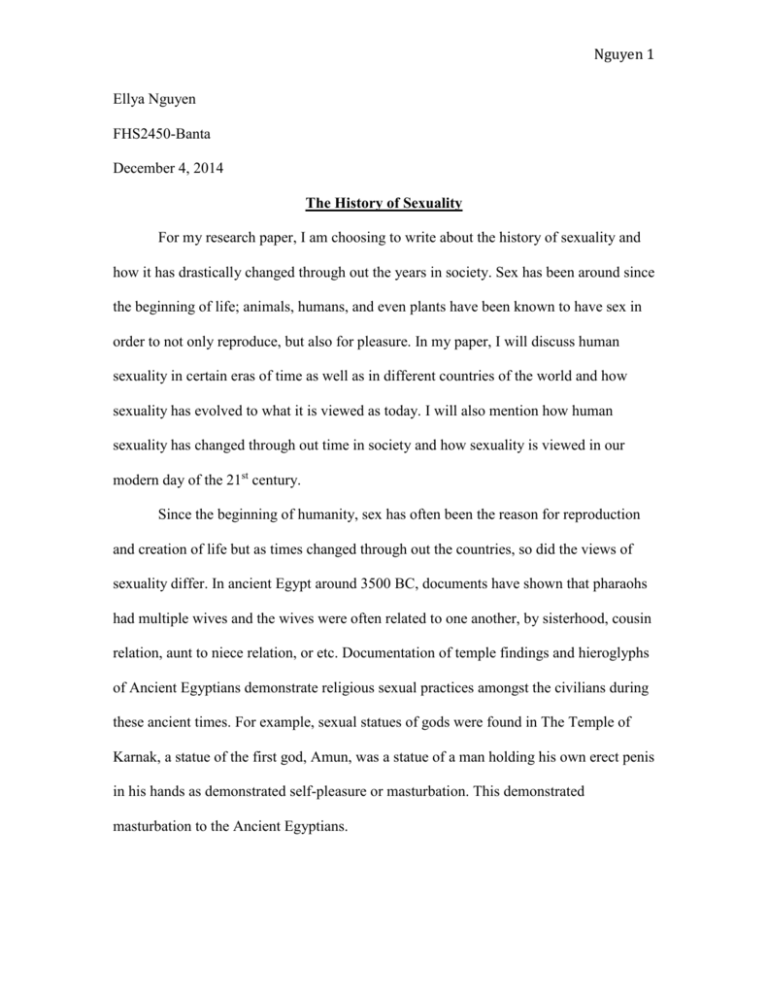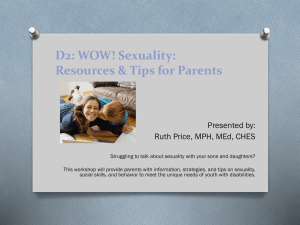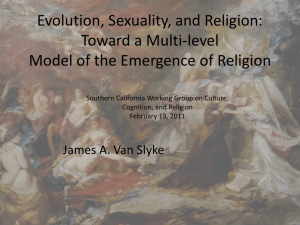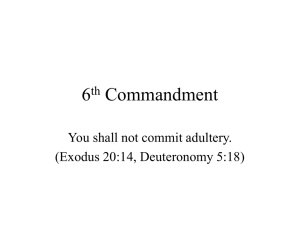
Nguyen 1
Ellya Nguyen
FHS2450-Banta
December 4, 2014
The History of Sexuality
For my research paper, I am choosing to write about the history of sexuality and
how it has drastically changed through out the years in society. Sex has been around since
the beginning of life; animals, humans, and even plants have been known to have sex in
order to not only reproduce, but also for pleasure. In my paper, I will discuss human
sexuality in certain eras of time as well as in different countries of the world and how
sexuality has evolved to what it is viewed as today. I will also mention how human
sexuality has changed through out time in society and how sexuality is viewed in our
modern day of the 21st century.
Since the beginning of humanity, sex has often been the reason for reproduction
and creation of life but as times changed through out the countries, so did the views of
sexuality differ. In ancient Egypt around 3500 BC, documents have shown that pharaohs
had multiple wives and the wives were often related to one another, by sisterhood, cousin
relation, aunt to niece relation, or etc. Documentation of temple findings and hieroglyphs
of Ancient Egyptians demonstrate religious sexual practices amongst the civilians during
these ancient times. For example, sexual statues of gods were found in The Temple of
Karnak, a statue of the first god, Amun, was a statue of a man holding his own erect penis
in his hands as demonstrated self-pleasure or masturbation. This demonstrated
masturbation to the Ancient Egyptians.
Nguyen 2
In Ancient Greece and Ancient Rome, human sexuality was often demonstrated
through the various gods that they worshipped and their sexual beliefs were often
associated with the religion. Each god they worshipped was known to be a god/goddess
of a certain power or characteristic. For example, the Greek goddess of love, beauty and
sex was Aphrodite and to the Romans, Venus was the goddess of love, beauty and sex.
Both Venus and Aphrodite played a large role in human sexuality to the Ancient Greeks
and Ancients Romans. Ancient Greeks and Romans also expressed human sexuality
greatly through out art. The human body was often the main focus in all types of art such
as paintings and especially sculptures. The paintings and sculptures found in these
ancient times often showed every detail of the naked human body and anatomy. At first,
these paintings and sculptures were looked down upon by civilians and looked at as sinful
because they portrayed nudity and sex. But as the era progressed in Ancient Rome and
Greece, the human body and anatomy was looked more at as art and beauty instead of a
sin.
India’s ancient history plays a large role in human sexuality as well. In modern
times, India is known to be the origin of how modern day people view and have certain
attitudes toward sexuality. India’s ancient history is known to have portrayed sex through
literature and art and has even been seen in religious temples of India. Ancient India is
known to have created the very popular and known text called the Kama Sutra. This text
is widely known to be the ‘standard work on human behavior’ in Sanskrit literature. The
Kama Sutra is known as a large text that consists of several chapters in which talk about
different topics of sexual behavior and intimacy in detail. Some of the topics mentioned
in the Kama Sutra are about amorous advances and sexual union, acquiring a wife, duties
Nguyen 3
and privileges of the wife, other men’s wives, and certain practices. The chapters go very
into depth of these subjects and mention several sexual behaviors in which humans
should engage in such as certain sex positions and foreplay. Historians believe that the
Kama Sutra was composed some time between 400 BCE and 200 CE. It is unbelievable
that it is still known and widely referred to in today’s modern time and has left a great
impact on sexual behavior as well as human sexuality.
During the early years in which Christ existed, sex was viewed as necessary for
reproduction, but looked down upon by religion. During this time, religion played a large
role in our sexuality. Unfortunately, we do not have much record or documentation of
Jesus Christ’s point of view about human sexuality, but the principles of love and
tolerance were the foundation of his teachings (Crooks & Baur, 2011, pg.11. However,
Paul of Tarsus, a follower of Christianity, had a crucial influence on the early church.
Paul Believed that all things of the flesh were bad, and only things of the spirit were
good- or “godly” (Crooks & Baur, 2011, pg. 11). Augustine was a bishop in which lived
from 354-430 AD and had declared that the original sin of Adam and Eve was lust. He
believed that sex and intercourse could only take place if two individuals were married
and it was a sin to have sex before marriage. During the Middle Ages (400-1400 AD),
sexuality was viewed as mainly for procreation and not for pleasure, it was almost a sin
to have sex for any further reason. If individuals had oral sex or anal sex, they were
severely punished sometimes worse than individuals who had committed a murder.
Anything sexual known as “unnatural” such as homosexuality, sex before marriage, anal
sex, oral sex, different sex positions besides man on top, were all known as very bad sins.
Most of these influences were due to religion and the bible.
Nguyen 4
After The Middle Ages, The Enlightenment, which took place around the 1500s,
human sexuality began to slowly change. Beliefs about sexuality were not as strict as in
The Middle Ages and gender roles began to change. People during The Enlightenment
era had seemed to become more comfortable about sex and having it occur for other
reasons rather than reproduction, but this was only if two individuals were married. If
individuals had sex before marriage, it was still viewed as a sin and a person should be
punished. But it was this era in which society’s view on sexuality began to really differ
and views became more positive towards sexuality than before in the Middle Ages.
Sexuality in both men and women began to change drastically as the Victorian
Era came upon society in the 1800’s. Gender roles were extremely strict during this time
era especially for women; each opposite sex had a certain defined role in society. Women
were known to have a specific duty, and that was to be a good wife who cooks, cleans
and serves her husband while men were known to work hard and have their wives serve
them in every way. Victorian men could smoke, drink, joke, and find sexual
companionship with the women who had turned to prostitution out of economic
necessity, whereas their wives were caught in the constraints of propriety and sexual
repression (Crooks & Baur, 2011, pg. 13). Both men and women lived in opposite worlds
in society of the Victorian Era.
As the 20th century approached after the Victorian Era, sexuality and gender roles
took a serious turn in society. Women broke out of the gender role that was often seen in
the Victorian Era, women rejected the clothing styles of the Victorian Era and changed
their images drastically. They cut their hair short, wore clothes that were more loose
rather than fitted, and broke the “at home” role that a woman portrayed during the 1800’s
Nguyen 5
by going out and becoming more independent. These women were known as “flappers”
in which were young, single, women in middle class which had broken free from the
Victorian ideal role a woman had to portray. The women’s suffrage movement also began
in the early 1900’s during the 20th century in which allowed women the right to vote and
was the start to the beginning of equality between men and women. During the 20th
century where gender roles were drastically changing for women, sexuality was also
changing. Couples expressed their sexuality differently than before in The Middle Ages
and it was not seen as a sin to have sex as pleasure rather than for procreation. Kissing
and foreplay were more common, and several individuals even had sex before marriage.
However, sex before marriage was still viewed down upon by society but an individual
would not be punished like before in the Middle Ages. Instead, if an individual had sex
before marriage, it was more of an issue that would jeopardize their own reputation in
society rather than a sin and punishment that needed to be done.
In the early 1900’s to mid 1900’s, during World War I and also World War II,
sexuality began to be displayed in the media and seen more often publicly that before.
The very first Playboy magazine was created during the 1950’s and displayed women in
which were viewed sexually and emphasized sex more as recreational and for pleasure
rather than procreation. Aside from sexuality seen more often in media, the surprising
statistics on same-sex behavior, masturbation, and novel acts in the bedroom contributed
to the growing acceptance of a variety of sexual behaviors (Crooks & Baur, 2011, pg.
16). Different sexual behaviors were often used and not seen as abnormal or atypical, as
it was centuries before.
Nguyen 6
As the years slowly progressed, sexuality seemed to become more of a normal
subject and people seemed to become more open to sexual material. Beginning in the
1960’s and throughout the 1970’s, feminism emerged as well as the “sexual revolution”
which is known as the drastic changes in which society changed it’s views of sexuality as
well as the creation of contraceptives. By this time, sex before marriage was not seen as
unusual or wrong, it was seen more of a purpose for pleasure rather than only creation of
life. Several contraceptives were intruded during the 1960’s, these include birth control
pills, spermicides, morning after pills, and the intrauterine device or also known as an
IUD. These contraceptives created the ability for both men and women to engage in
sexual intercourse with out the worry of conceiving a child. However, contraceptives
were not always legal when they were first introduced to society. It was not until 1965
(five years after contraceptives were introduced) that the Supreme Court made
contraceptives legal by the use of married couples and by 1972, the use of contraceptives
were then legal for individuals who were not married. During this time in the 1960’s and
1970’s, attitudes and beliefs about homosexuality began to change and people were much
more open about their sexuality and sexual orientation. Gays and Lesbians began to
openly declare their sexual orientation and to argue that such a personal matter should not
affect their rights and responsibilities as citizens (Crooks & Baur, 2011, pg. 17).
Homosexuality was seen as less of a mental issue and individuals began to feel more
comfortable with their sexual orientation.
In today’s society, the 21st century, human sexuality is seen as something that is
quite natural and common through out one another and people have learned to understand
human sexuality more as time progresses. We often see sex displayed in the media on a
Nguyen 7
daily basis. Sex is often portrayed in the media greatly such as in advertisements,
television, movies, magazines, and the Internet. Every country worldwide is exposed to
these types of material even to young individuals. It is quite common to hear about
other’s sexual experiences or sexual orientation in today’s society and it is seen as a
normal aspect and not so much of as a sin, as it was viewed centuries ago. I believe that
as time has progressed, technology and research also enhanced created a better
understanding of human sexuality and how we as humans function sexually. Human
sexuality has always been a very private topic since the beginning of humanity, but as
new times have evolved, our sexuality is expressed more comfortably as a society and
better understood as individuals.
Nguyen 8
Work Cited
Our Sexuality, Eleventh edition. Robert Crooks, Karla Baur, 2011.
http://historyofsexuality.umwblogs.org
http://en.wikipedia.org/wiki/Kama_Sutra
http://www.sexualecstasy.org
http://www.h-net.org/reviews/showrev.php?id=12102
http://www.pearsonhighered.com/assets/hip/us/hip_us_pearsonhighered/samplechapter/0
205989322.pdf
http://books.google.com/books?id=cqlAgAAQBAJ&pg=PA260&lpg=PA260&dq=histor
y+of+human+sexuality+in+greece&source=bl&ots=nxb0wBbQez&sig=A4HHlW9kHW
Dsp3b83rXuHArDIag&hl=en&sa=X&ei=rgyBVPHGM2xogTG7oGwAQ&ved=0CFcQ6AEwCA#v=onepage&q=history%20of%20human
%20sexuality%20in%20greece&f=false
http://www.goodreads.com/topic/show/1496856-ancient-human-sexuality







